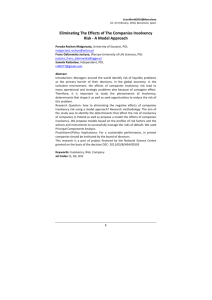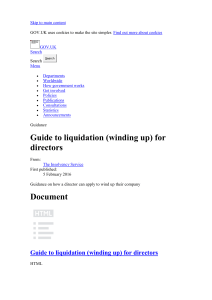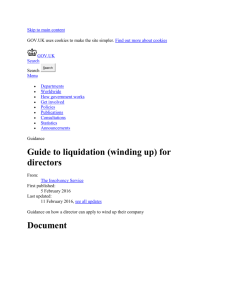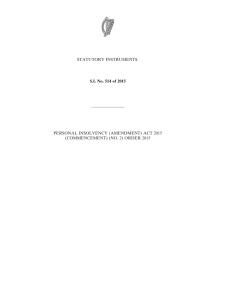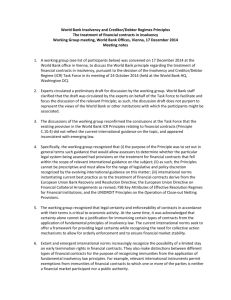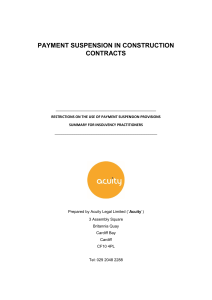share price volatility
advertisement
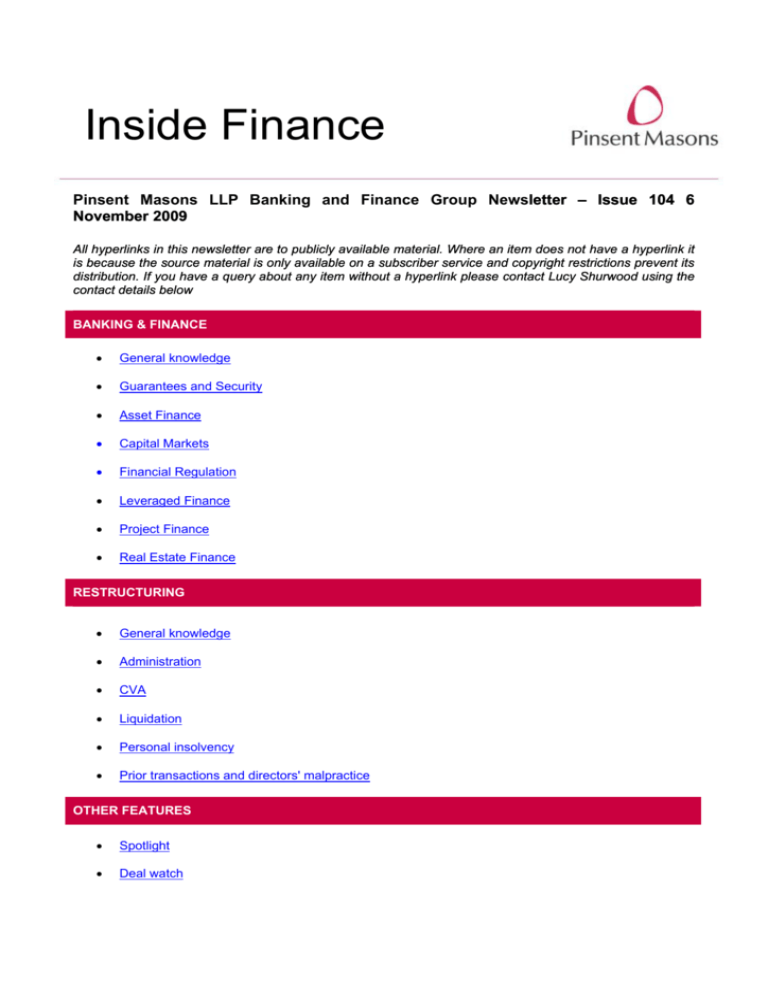
Inside Finance Pinsent Masons LLP Banking and Finance Group Newsletter – Issue [ ] [ ] 2009 Pinsent Masons LLP Banking and Finance Group Newsletter letter – Issue 104 6 November 2009 All hyperlinks in this newsletter are to publicly available material. Where an item does not have a hyperlink it is because the source material is only available on a subscriber service and copyright restrictions prevent its distribution. If you have a query about any item without a hyperlink please contact Lucy Shurwood using the contact details below BANKING & FINANCE • General knowledge • Guarantees and Security • Asset Finance • Capital Markets • Financial Regulation • Leveraged Finance • Project Finance • Real Estate Finance RESTRUCTURING • General knowledge • Administration • CVA • Liquidation • Personal insolvency • Prior transactions and directors' malpractice OTHER FEATURES • Spotlight • Deal watch SPOTLIGHT – our quarterly look at a hot legal topic…..this month: Slavenburg resurrected?? The implementation of Part 25 of the Companies Act 2006 and the Overseas Companies (Execution of Documents and Registration of Charges) Regulations 2009 were supposed to spell the end for Slavenburg registrations - so why is there talk of bringing them back? The Overseas Companies Regulations 2009 (the "OC Regulations") require a company with a UK establishment to register at Companies House. The Overseas Companies (Execution of Documents and Registration of Charges) Regulations 2009 (the "Registration Regulations") provide that a charge granted by an overseas company is only registrable if: (a) it is one of the types of mortgage or charge registrable by a company incorporated in England and Wales or Northern Ireland; (b) on the date it is created, the overseas company granting it has registered particulars of a places of business under the OC Regulations and those particulars have been entered on the register and are available for public inspection; and (c) on the date it is created, the property subject to the mortgage or charge is situated in the UK. The intention behind the Registration Regulations was that a chargee, when taking security from an overseas company, could simply search against the name of the overseas company at Companies House. If the search did not show that the overseas company was registered the charge would not be registrable at Companies House. Slavenburg registrations would be a thing of the past. However, there is a complication. Section 1048 of the Companies Act 2009 allows an overseas company that is required to register particulars with Companies House under the OC Regulations to deliver to the registrar for registration a statement specifying a name, other than its corporate name, under which it proposes to carry on business in the UK. If this is done, pursuant to section 1048(3), the alternative name under which the company is registered "is treated for all purposes of the law applying in the United Kingdom as the company's corporate name". Companies House has confirmed, in correspondence conducted on behalf of the City finance PSLs group, that at present a search against a company's corporate name would not reveal any alternative name under which it may have registered in the UK. It is therefore possible that, whilst security would be taken from the company under its corporate name, it could have registered at Companies House under an alternative business name (of which the chargee may not be aware). A search at Companies House against the corporate name (in which the security was taken) would not reveal the established place of business registered under the alternative name. In the circumstances outlined above, the risk to the chargee is that, in spite of it having undertaken a search at Companies House which did not reveal a registered place of business for the overseas company, the overseas company does have a registered place of business under an alternative name and therefore the charge is registrable. If the Companies House search did not reveal a registered place of business, the chargee would not register the charge. Failure to register a registrable charge within the 21 day time period would render the charge void as against a liquidator, administrator or creditor. It has been suggested that one way of dealing with this would be to continue with a form of "Slavenburg" registration, i.e. deliver particulars of the charge to Companies House even if a Companies House search does not reveal a registration for an overseas chargor. This is despite the fact that the Slavenburg registration regime no longer exists and Companies House will no longer accept registrations of charges granted by unregistered overseas companies. The rationale for this attempted registration is that by delivering particulars of the charge to Companies House the chargee has complied with its obligations under the Registration Regulations and therefore the charge would not be void as against a liquidator, administrator or creditor. However, it is arguable that delivery of these particulars would not meet the requirements of the Registration Regulations: the particulars would not contain the company number or the name under which the company was registered and therefore arguably would not constitute "required particulars" for the purposes of the Registration Regulations. It is also questionable whether attempted registration under the wrong company name would be held by a court to constitute registration at all, notwithstanding that it the chargee did not know it was using the wrong name. It is possible that the courts would be even more inclined to disregard these attempted registrations when it is considered that one of the principal purposes of the Registration Regulations was to bring an end to the Slavenburg registration regime. An alternative would be to require the chargor to confirm whether it was registered in the UK and, if so, what name it was registered under. This would involve including a representation in the facilities agreement that no obligor has registered (under any name) in the UK or, if it has, that it has registered under a specified name or number. If there were particular concerns about whether the company had properly directed its mind to this point, a director's certificate could also be sought to back this up. If necessary, an undertaking could also be included in the facilities agreement requiring the company to notify the agent/lender if at any time it did register in the UK, but this is probably superfluous if the representation is repeated and no further security is taken after the date of the facilities agreement. Any opinion given on the Finance Documents would also need to contain an assumption that no obligor had registered in the UK (as there is no definitive way to confirm this independently). It has been suggested that relying on the borrowers' confirmation in this way leaves a residual risk to the lender that, if the information provided by the borrower is incorrect, its security will be void. However, this risk only arises in circumstances where the borrower has, negligently or fraudulently, withheld information from the lender and, as always, it is difficult (if not impossible) to allow for a borrower failing to disclose accurate information when asked directly to do so. As always there is a balance to be struck between the risk to the validity of the security and the time, cost and potential ineffectiveness of continuing to attempt registration of charges granted by overseas companies, even where they do not appear to have registered at Companies House. Companies House has indicated that it is taking its own legal advice on the matter and there are hopes that it may be able to resolve this issue completely by upgrading the search function for overseas companies. BANKING & FINANCE - General knowledge High Court considers meaning of all reasonable endeavours and if distribution agreement validly novated or assigned: the High Court has considered the issues of when consent to the assignment or novation of a contract can be inferred from the parties' conduct, and whether a party was in breach of its obligation to use all reasonable endeavours to promote the sale of certain products. Although the case was decided on its facts, the judge's analysis of the claimants' actions is a helpful illustration of the practical steps that a party who is subject to an all reasonable endeavours obligation to promote the sale of products might be required to take to discharge the obligation. The case is also a helpful illustration of issues that can arise when a party to a contract attempts to establish an assignment or novation through conduct. CEP Holdings Ltd v CEP Claddings Ltd [2009] EWHC 2447 (QB). Agreements to agree: the Scottish Court of Session has held that an agreement to use all reasonable endeavours to agree a purchase price wholly acceptable to the seller in respect of the purchase of land was enforceable. In R & D Construction Group Ltd v. Hallam Land Management Ltd [2009] ScotCS CSOH_128, the Court of Session found that while the "wholly acceptable" element of the condition was a subjective criterion, this did not make the condition unenforceable because the obligation was directed towards a particular object. This object was only the negotiation of the purchase price under the terms of the option agreement, rather than the negotiation of the whole agreement. This case confirms that the courts will, in some circumstances, enforce an agreement to agree. Cash pooling: an article from PLC magazine outlines different types of cash pooling, explaining its increasing relevance and examining the legal and practical issues involved in its use. Payments made in error: Banking partner Tony Anderson has written an article for the Lawyer considering the recent case of Jones v Churcher and Abbey National plc (2009). The article looks at current practices between remitting and beneficiary banks where payments have been made in error. Tax and debt buybacks: on 14 October 2009, the Treasury announced changes to the rules on the way groups of companies are taxed when they buy back their debt at a discount to the amount at which they borrowed it. On 22 October 2009, HM Revenue & Customs issued a note to clarify some aspects of the announcement. Defaulting lender provisions in the US: PLC US magazine has published an article - "What's market: defaulting lenders" considering the market standard for defaulting lender provisions in the US. Banks not liable for loss of profit: on 8 October 2009 in Timothy Duncan Earles v Barclays Bank PLC [2009] EWHC 2500 (Mercantile), the High Court considered a clause limiting the bank's liability for damages in the case of breach of contract. The clause read: "We will not be liable to you in any circumstance for: Loss of business, loss of goodwill, loss of opportunity, loss of profit; Any type of special, consequential or indirect loss whatsoever." The court held that it was entirely reasonable for a bank to limit the commercial consequences for any defaults by it in the provision of its services to commercial customers. The judge commented that commercial customers took considerable risks in return for profit while the bank made no such trade off. The clause was therefore fair under the Unfair Contract Terms Act 1977. The case was primarily concerned with disclosure requirements and the weighing of factual evidence. The judge gave his opinion on the limitation of liability clause in passing (his decisions earlier in the judgment meant that the point was no longer relevant to the case). However, the clause is commonly used so a statement by the court that it is considered to be fair and enforceable is likely to be of interest to lenders and financial service providers. Reductions of capital: memorandum on solvency statement procedure published on CLLS website: on 5 October 2009 a memorandum relating to reductions of capital supported by solvency statements was published by the City of London Law Society. The solvency statement procedure for effecting reductions of capital (under sections 641 to 644 of the Companies Act 2006) was introduced for private companies with effect from 1 October 2008 as an alternative to court-approved reductions. The memorandum records some consensus views of members of the Company Law Committee of the Law Society as to practical steps directors can take before making a solvency statement to reduce the risk of committing an offence under section 643(4) of the 2006 Act. BANKING & FINANCE – Guarantees and security The difference between a primary and secondary obligation: the Journal of International Banking Law has published an article (“Guaranteeing Certainty”) on the difference between a primary and secondary obligation, in light of the recent Court of Appeal decision in Associated British Ports v Ferryways NV. Command performance: no mercy for on demand guarantors: on 6 October 2009, the High Court ruled in Enka Insaat Ve Sanayi AS v Banca Popolare Dell'alto Adige SPA [2009] EWHC 2410 (Comm) that the beneficiary of an on demand performance guarantee is under no obligation to show that the damage caused by the breaches relied on to enforce the guarantee is commensurate with the money claimed under the guarantee. Enforcement of guarantees: construction projects: Property Law Journal (P.L.J. 2009, 238, 17-19) has published an article which examines the drafting and enforcement of guarantees, given by parent or sponsor companies to development project lenders, in the construction and development sector. The article explains the formalities and types of performance and financial guarantee and reviews, with reference to relevant cases, the situations where a guarantee might be unenforceable including non-consensual variations of liability, the winding up or dissolution of the borrower, and the expiration of time or judgment. It also observes the practical problems of enforcing guarantees. Place of performance of guarantee: the High Court has held that where a guarantee is governed by English law, in the absence of an express provision, the place of performance is the creditor’s place of business, which is where the creditor is entitled to commence proceedings against the guarantor under the Brussels Regulation. See Commercial Marine Piling Ltd v Pierse Contracting Ltd [2009] EWHC 2241 (TCC) for further details. Supreme Court gives judgment in Sigma Finance Corp case: the Supreme Court has reversed the decisions of the High Court and the Court of Appeal in the case of Re Sigma Finance Corporation [2009] UKSC 2. Whilst the lower courts had held that the receivers were obliged to pay liabilities falling due for payment during the Realisation Period as they fell due, the Supreme Court disagreed and held that, on the construction of the overall scheme of distributions in the Security Trust Deed, liabilities falling due for payment during the Realisation Period should form part of the pool of assets available to all creditors in respect of short term liabilities and be distributed pari passu. The decision is interesting because it reverses those of the courts below, giving greater weight to the other provisions of the Security Trust Deed rather than focusing narrowly on the discrete sentence relating to payments during the Realisation Period. Lord Mance, giving the leading judgment, also noted that the clause in question "was drafted in contemplation of the situation where no question of insolvency arose" - highlighting the fact that possibly adequate consideration was not given to the possibility of Sigma becoming insolvent when certain provisions were drafted. BANKING & FINANCE - Asset Finance New valuation method for ships triggers inflation fears: HSH Nordbank and Deutsche Shiffsbank have endorsed the Hamburg Ship Evaluation Standard, which will produce ship values well above market rates in a move that has raised concerns over the potential inflation in value of billons of euros in assets should other banks follow suit. BANKING & FINANCE - Capital Markets Exclusive jurisdiction agreements and non-parties: In Morgan Stanley & Co International Plc v China Haisheng Juice Holdings Co Ltd [2009] EWHC 2409 (Comm), the court had to consider the question of whether an exclusive jurisdiction clause in favour of the English courts extended to claims against an entity that was not a party to the agreement. The exclusive jurisdiction clause was contained in an agreement between the parties based on the ISDA Master Agreement (2002 form). BANKING & FINANCE - Financial Regulation Too big to fail: the FSA has published a discussion paper on measures to address the problem of systemically important ‘too-big-to-fail’ banks. The paper also examines the trade-offs involved in increasing capital and liquidity requirements, and stresses the need to assess the cumulative impact of multiple reforms. BANKING & FINANCE - Leveraged Finance VAT recovery on deal costs: HMRC are challenging VAT recovery on deal costs in relation to corporate finance transactions. There are a couple of test cases currently going through the Tax Tribunal. HMRC are mounting two main challenges: Where the deal costs are billed to a Newco, which was incorporated only shortly before the transaction and after engagement letters were signed and costs incurred - they argue that the services cannot have been supplied to Newco if it did not exist at the relevant time. This will be particularly relevant on private equity transactions where a SPV will be incorporated for the purposes of making the acquisition. Where services (eg due diligence) are supplied jointly to the bank/investors and the Buyer - they argue that the supply is really to the bank/investors who typically can not recover VAT. This challenge could have implications for the terms of engagement of professionals on corporate finance transactions. BANKING & FINANCE - Project Finance PfS appoints 15 firms to academies frameworks: Following its announcement of its shortlists in May 2009, Partnerships for Schools (PfS) has announced the 15 successful firms who now have a place on the two regional academies frameworks. With the education sector, PfS and public spending all high on the political agenda at the moment, the construction and engineering industries and local authorities affected by academies schemes will be hoping that PfS can successfully navigate potentially troubled waters, to successfully procure the new projects. NAO: Performance of PFI Construction review: on 5 October 2009, the National Audit Office (NAO) published Performance of PFI Construction (Review), a review of the performance of PFI projects. The Review updates a previous report published by the NAO in 2003 and follows two surveys undertaken in 2008. The Review finds that: A majority of PFI projects are still being delivered on time or with only minor delays. However, an increasing number of projects are being delivered more than two months late. A majority of PFI projects are being delivered on, or close to, the price originally quoted. However, the number of projects delivered exactly to the originally contracted price has declined. This is due to public sector bodies instructing changes to projects after contracts have been signed. In comparison with PFI, non-PFI public sector construction projects have delivered on time in around two thirds of cases and on budget in around half. A majority of PFI projects receive good user and quality ratings and environmental evaluations are becoming more routine. PFI experience is lacking in many public sector project teams and this is an important part of managing PFI contracts. Source: NAO: Performance of PFI Construction. BANKING & FINANCE - Real Estate Finance Land Registry updates practice guides: points to note for finance lawyers: the Land Registry has updated a number of practice guides in light of the Land Registration (Amendment) Rules 2009, which came into force on 1 October 2009. The following amended practice guides are of particular interest to finance lawyers: Execution of deeds (Practice Guide 8). Approval of mortgage documentation (Practice Guide 30). Discharges of charges (Practice Guide 31). To access the Land Registry practice guides, go to: http://www.landreg.gov.uk/publications/?pubtype=309 RESTRUCTURING - General knowledge Continuity preserved where buyer took on employee of insolvent business: the long-awaited transcript of the Court of Appeal's decision in Oakland v Wellswood (Yorkshire) Ltd [2009] EWCA Civ 1094 has now been published. The Court held that continuity of employment was preserved by section 218 of the Employment Rights Act 1996 when an employee of a company in administration was employed by the buyer following a pre-pack sale. The question of whether, and in what circumstances, the buyer in a pre-pack administration can avoid the automatic transfer of employees by virtue of regulation 8(7) of the Transfer of Undertakings (Protection of Employment) Regulations 2006 remains uncertain. However, buyers should be aware that, whatever the position under TUPE, any existing employees actually taken on will have their continuity preserved. Retention of title and EU law: the European Court of Justice has held that claims based on retention of title fall within the broad concept of civil and commercial matters for the purposes of the EU Regulation on Recognition and Enforcement of Judgments and therefore under the EU Insolvency Regulation retention of title claims need not be brought in the member state where main proceedings have been opened. The court held that an action concerning a reservation of title clause constitutes an independent claim, as it is not based on the law of the insolvency proceedings and requires neither the opening of such proceedings nor the involvement of a liquidator. In those circumstances, the mere fact that the liquidator is a party to the proceedings is not sufficient to classify those proceedings as proceedings deriving directly from the insolvency and being closely linked to proceedings for realising assets. See German Graphics Graphische Maschinen GmbH [2009] EUECJ C-292/08 for full judgment. City of London Law Society response to evaluation of EU Insolvency Regulation: the Insolvency Law Committee of the CLLS has published its response to the evaluation of the EU Insolvency Regulation. The response provides a useful summary of the case law on the Regulation and highlights key issues with the application of the Regulation by the courts (so far). Insolvency Service gives an update on the reform of the Insolvency Rules: the Insolvency Service has published an update on progress with the reform of the insolvency rules. The implementation timetable is unchanged. Interim amendments to the Insolvency Rules 1986 (1986 Rules) will be made with effect from 6 April 2010. A revised and consolidated set of rules will come into force to replace the 1986 Rules in April 2011. The main aims of the proposed changes are: to increase the use of electronic communication in formal insolvency procedures (including allowing remote attendance at creditor meetings). to promote transparency (especially in relation to the remuneration of insolvency practitioners) and simplicity (for example, by reducing the volume of court filings). Of particular note is the intention to allow creditors to approve the payment of costs incurred by a prospective administrator before he takes office as expenses of an administration. To read the Insolvency Service's update in full, click here. Contribution notices: DWP unwilling to extend insolvency practitioner exemption to receivers: the Department for Work and Pensions has rejected a call to extend the exemption from contribution notices issued by the Pensions Regulator to cover receivers. In contrast to administrative receivers, who historically assumed responsibility for most of a company's property under floating charges, receivers are typically appointed to enforce security held by fixed chargeholders. They are frequently not licensed insolvency practitioners. Under section 38(3) of the Pensions Act 2004 (PA 2004), the Regulator cannot issue a contribution notice to a person "acting in accordance with his functions as an insolvency practitioner". As defined in section 388 of the Insolvency Act 1986 and section 121 of the PA 2004, this includes an administrative receiver, but does not cover a receiver who is not a licensed insolvency practitioner. In response to concerns raised about this omission by the Financial Markets Law Committee, the DWP has ruled out amending the law. The DWP suggests that the terms of a security could provide that a receiver's assumption of liability would be conditional on clearance being obtained from the Regulator. More generally, the DWP says that "the perceived risk to receivers is mitigated by safeguards contained in the legislation". It notes two particular points: The Regulator must conclude that it is "reasonable" to issue a contribution notice by reference to a set of factors listed in the PA 2004, including whether it was reasonable for the potential recipient to act as they did. The decision to issue a contribution notice is taken by the independent determinations panel rather than by the Regulator's investigative staff. The recipient of a notice can appeal against the decision to the Pensions Regulator Tribunal and ultimately to the Court of Appeal. Source: Letter from the DWP to the FMLC, 5 October 2009. Supreme Court gives judgment in Sigma Finance Corp case: the Supreme Court has reversed the decisions of the High Court and the Court of Appeal in the case of Re Sigma Finance Corporation [2009] UKSC 2. Whilst the lower courts had held that the receivers were obliged to pay liabilities falling due for payment during the Realisation Period as they fell due, the Supreme Court disagreed and held that, on the construction of the overall scheme of distributions in the Security Trust Deed, liabilities falling due for payment during the Realisation Period should form part of the pool of assets available to all creditors in respect of short term liabilities and be distributed pari passu. The decision is interesting because it reverses those of the courts below, giving greater weight to the other provisions of the Security Trust Deed rather than focusing narrowly on the discrete sentence relating to payments during the Realisation Period. Lord Mance, giving the leading judgment, also noted that the clause in question "was drafted in contemplation of the situation where no question of insolvency arose" - highlighting the fact that possibly adequate consideration was not given to the possibility of Sigma becoming insolvent when certain provisions were drafted. RESTRUCTURING – Administration Consequences of failure to comply with SIP16: the High Court has held that a failure to comply with Statement of Insolvency Practice 16 alone is not a basis for removing an administrator from office. The court also did not accept that the lack of prior consultation with creditors amounted to grounds on which to remove the administrator from office - keeping creditors in the dark about the sale was a legitimate pre-pack tactic, if it was adopted honestly and assisted the administrator in getting a better deal for creditors. However, the court did order the removal of the administrator from office as there was no clear evidence that the deal to sell the company was the best available and the administrator could not review the deal because he lacked independence, having been involved in the negotiation and sale process. Clydesdale Financial Services Limited and others v Smailes [2009] EWHC 1745 (Ch) (not yet reported). The balancing act under section 236 of the Insolvency Act 1986: third parties often hold information and documents relating to the affairs of an insolvent company. Administrators and liquidators can seek a court order requiring a third party to provide them with such information (section 236, Insolvency Act 1986 (1986 Act)). In Cowlishaw and Wong v O&D Building Contractors Limited [2009] EWHC 2445 (Ch), the High Court refused an application under section 236 of the 1986 Act, made by the administrators of an insolvent company. The High Court balanced the benefit to the administrators and the creditors of the insolvent company in having the information against the prejudice to the third party in having to provide it. The High Court found that the balance fell against the administrators. The key factors in the High Court's decision were: The administrators had not shown an inability to obtain some or all of the information sought from other sources. The administrators couched their request for information (and the justification for requesting that information) in general terms, rather than asking for specific documents and information to achieve specific ends. This meant that the prospective burden on the third party in complying with the administrators' request was disproportionate to the identified benefit to the insolvent company and its creditors. The insolvent company had not paid the third party for creating the information sought and had no contractual right to the documentation requested. Application of the insolvency set-off rules in administration clarified by the High Court: in In the matter of Kaupthing, Singer and Friedlander Limited (in administration) [2009] EWHC 2308 (Ch), the High Court clarified the application of insolvency set-off in administration. Rules 2.85 to 2.89 of the Insolvency Rules 1986 (the 1986 Rules) set out how insolvency set-off applies in the distribution of assets in an administration. Rule 2.105 of the 1986 Rules sets out how an administrator should discount future debts when applying insolvency set-off. The administrators of an insolvent bank wanted to distribute the bank's assets to its depositors. Some of the depositors had also borrowed money from the bank. The administrators asked the High Court to clarify the extent to which the administrators should set off the debts due from a depositor to the bank against the debt due from the bank to the depositor. The High Court held: A "future debt" for the purpose of the relevant 1986 Rules was any debt that fell due after the bank went into administration. For the purposes of insolvency set-off, future debts that fall due after the administrators notify creditors of their intention to distribute assets are subject to a discount (using the formula set out in rule 2.105 of the 1986 Rules). The administrators should apply the rules on the quantification of debts (in rules 2.86 to 2.88 of the 1986 Rules) to debts due to and from the insolvent bank. The administrators should not include any interest that accrued after the insolvent bank went into administration. Administration expenses: new scope for "necessary disbursements"? In Lomas & Ors v RAB Market Cycles (Master) Fund Limited & Ors [2009] EWHC 2545 (Ch), the administrators of Lehman Brothers International (Europe) (LBIE) sought the court's directions in relation to certain amounts of cash received by LBIE post-administration, which related to securities held by LBIE on behalf of prime brokerage clients. The court held that, on a proper construction of the prime brokerage contract, the cash was subject to a trust on behalf of the owners of the security. Accordingly, the administrators were entitled to distribute the cash to the beneficiaries. The court went on to consider, as an alternative, whether distribution of the cash could be regarded as a "necessary disbursement" and, therefore, an administration expense within the meaning of Insolvency Rule 2.67(1)(f). It was held that payments ought to be made in fairness and justice to the relevant clients because the administrators had retained, against the clients' instructions, the securities in relation to which the cash had been received. On that basis alone, the payments ought properly to be described as a "necessary disbursement". RBS awaits court ruling on Cattles and the terms of a guarantee: RBS has argued in the High Court that it should have priority over bondholders if Cattles, the doorstep lender went into administration. RBS, which is the biggest bank lender to Cattles, told the High Court that its claim ranks ahead of bondholders because of a guarantee given to the banks by Welcome, a Cattles subsidiary. The court is being asked to decide, in the event of an administration, whether the words of this guarantee will mean Cattles’ banks and private placement noteholders will receive most of the cash the company gets back from its customers. William Trower, QC, representing RBS said that the case hinged on a key clause in the guarantee which said that no guarantor “shall in competition with or in priority to the bank make any claim against any debtor or co-guarantor or their respective estate or make a claim in the insolvency of any debtor….” He said the clause was “about preserving the pot against which RBS can recover, and said there was “no linguistic ambiguity” about it. However Robin Knowles QC acting for party A, who is an unidentified bondholder, said that if RBS’s interpretation of the clause was right, Cattles had signed away its main asset for a period until RBS had been paid in full. The hearing has concluded and a judgment is expected in due course. RESTRUCTURING – CVA "Lehman and the hedge funds: a scheme too far?" – this article from PLC magazine considersthe extent of the meaning of "a compromise or arrangement" within the scope of Part 26 of the Companies Act 2006 and the court’s jurisdiction to sanction such a scheme of arrangement (a scheme) so as to bind a dissenting minority in the context of the recent High Court case In the matter of Lehman Brothers International (Europe) (in administration) (No 2) [2009] EWHC 2141.CVAs, JJB and proposals by the Insolvency Service to improve the CVA process: Accountancy (2009, 144(1394), 39-40) has published an article discussing the use of company voluntary arrangements as a form of corporate rescue. The article summarises the basic features of a CVA and notes proposals by the Insolvency Service to improve the CVA process. The article includes a box describing, by way of case study, the CVA implemented for the retailer JJB. RESTRUCTURING – Liquidation Is summary judgment ever appropriate in insolvency claims? the decision in Phillips & Another v McGregor-Paterson [2009] EWHC 2385 (Ch) related to various claims brought by the liquidators of a company against a former director (D). The claims against D were based on various sections of the Insolvency Act 1986, namely: • Avoidance of dispositions of the company's property after the commencement of winding up (section 127). Misapplication of the company's property and/or misfeasance and/or breach of fiduciary duty (section 212). Wrongful trading (section 214). Preferences (section 239). The judgment is interesting in that it suggests that summary judgment will rarely, if ever, be appropriate to determine these types of claim. The liquidators obtained summary judgment against D. D's appeal was allowed. The appeal judge held that the master had been wrong to conclude, on the evidence available to him, that D's defence to each of these claims had no prospect of succeeding. For a transaction to be set aside as a preference, it must be shown that the company's decision to enter into the transaction had been influenced by a desire to put the beneficiary in a better position than it would otherwise have been in on the company's insolvency. The necessary desire is presumed to have existed where the beneficiary of the preference is a person connected with the company (section 239(6)). The presumption can, however, be rebutted. The judge commented that it would be only in the clearest of cases that it would be possible to determine whether or not the statutory presumption has been rebutted without a full trial. Moreover, claims for preference require establishing that the payment was made at a time when the company was unable to pay its debts (sections 240(2) and 123). The judge said that whether the company was unable to pay its debts at the time of each of the relevant payments was a question that "cannot possibly be determined on a summary basis". The judge also suggested that a claim for misfeasance against a director cannot be disposed of summarily: issues of whether the director was in breach of his statutory and/or fiduciary duties, and, if so, whether and to what extent he should be excused for those breaches, are questions that require the full examination of evidence at trial. This means that insolvency practitioners who wish to pursue these types of claims must be prepared to pursue them to trial and secure the necessary funding to do so. The decision also addresses two technical points on procedure: The liquidators brought the claims under CPR Part 7, although they should have been made by an ordinary application in the winding-up proceedings under rule 7.2(2) of the Insolvency Rules 1986 (SI 1986/1925). The court noted that it was desirable that applications should be heard by a registrar with specialized knowledge of insolvency proceedings. However, because no injustice had been caused to the defendant as a result of the claims not being brought under the Insolvency Rules 1986, this would not invalidate the claim. • The value of the claim stated in the claim form was considerably less than the value claimed in the particulars of claim. Therefore, the issue fee paid under the Civil Proceedings Fees Order was significantly less than it should have been. The court required this underpayment to be remedied. This confirms that understating the value in a claim form will not allow a claimant to benefit from a lower fee on issue. RESTRUCTURING - Personal insolvency High Court considers how contingent is "contingent" in the context of bankruptcy debts: upon the discharge of his bankruptcy, a bankrupt is released from his bankruptcy debts (section 281, Insolvency Act 1986 (1986 Act)). Bankruptcy debts include debts or liabilities which arise from an obligation incurred before the bankruptcy, but which fall due afterwards (section 382, 1986 Act). Casson and Wales v The Law Society [2009] EWHC 1943 (Admin) concerned a compensation award made by the Legal Complaints Service against two solicitors who gave inadequate advice to clients. The solicitors were discharged bankrupts. They argued that, as they gave the advice complained of before being made bankrupt, the compensation awards were bankruptcy debts. Consequently, the solicitors' case was that their discharge from bankruptcy relieved them of the obligation to pay compensation. The High Court held that for there to be a bankruptcy debt there must be an obligation that will inevitably result in a payment falling due after the bankruptcy. In this case, the payment obligation did not arise until the LCS made a compensation award. The LCS had discretion not to make an award. Consequently, even though the advice that led to the compensation awards being made was given before the bankruptcy, there was no element of inevitability about the awards being made, so the awards were not bankruptcy debts. RESTRUCTURING – Prior transactions and directors' malpractice Preference claims and guarantees in the spotlight: in In the matter of Oxford Pharmaceuticals Limited [2009] EWHC 1753 (Ch) (not yet reported), the High Court considered an application by a liquidator to set aside payments by an insolvent subsidiary to its parent company as preferences under section 239 of the Insolvency Act 1986 (1986 Act). M was a director of, and guarantor of the liabilities of, the insolvent subsidiary and also of its parent company. The liquidator of the insolvent subsidiary argued that there was a preference under section 239(4) if, as a result of the payments, the director was put in a better position in the event of an insolvent liquidation of the subsidiary. This was whether or not the improvement in his position arose in his capacity as guarantor of the subsidiary or otherwise (such as, as a guarantor of the subsidiary's parent company). The High Court did not agree with the liquidator's interpretation of section 239(4) of the 1986 Act. The liquidator's interpretation would mean that section 239(4) could operate to require a person to disgorge a benefit obtained in some other capacity just because they happened to be a guarantor or surety and even though the benefit had nothing to do with their status as a guarantor or surety. Trading loss can be a loss to the insolvent company: the High Court has held that a trading loss was, in principle, capable of being a loss to the insolvent company recoverable under section 212 of the Insolvency Act 1986. In In the matter of E D Games [2009] EWHC 233 (not yet reported) it was held that money that the company did not pay to HMRC in VAT (because the director caused the company not to file VAT returns in breach of his duties as a director) effectively funded the company to trade. That trading increased the overall net shortfall on the company’s balance sheet. This meant that the company traded on beyond the point at which it would otherwise have ceased trading for lack of working capital, which generated a loss. In principle, that loss was capable of being a loss to the company recoverable under section 212. FRC publishes revised Guidance for Directors on Going Concern Assessments and Disclosures: The Financial Reporting Council (FRC), the United Kingdom’s independent regulator responsible for promoting confidence in corporate reporting and governance, has published updated Guidance for directors of UK companies to assist them when making their assessment of going concern. The Guidance is based on three principles covering the process which directors should follow when assessing going concern, the period covered by the assessment and the disclosures on going concern and liquidity risk. The Guidance emphasises the importance of balanced, proportionate and clear disclosures about going concern issues and the key assumptions being made in one place in an annual report. See guidance for more information. DEALWATCH – our quarterly report on what the Banking and Restructuring teams have been up to… Gerber Emig Group: working with our alliance partner Salans, we have advised HSBC Bank plc and Rabobank International as co-ordinating mandated lead arrangers providing EUR75.4 million and £65 million facilities to Gerber Emig Group. The facility also included Commerzbank, Lloyds Banking Group and The Royal Bank of Scotland as mandated lead arrangers and Santander as lead arranger. The proceeds of the facility will be used to refinance existing debt. The borrower, whose subsidiary Emig is headquartered in Hamburg, is based in the UK but also has manufacturing operations in Germany, France and Poland. Consequently, the transaction required advice to be given in respect of each of English, German, French and Polish law. Commenting on the advice provided by Pinsent Masons and Salans, HSBC Bank plc Director Matthew Osborne said, "The legal process on this deal went very smoothly and we thought Pinsent Masons and Salans did an excellent job. The Alliance between the two firms, who between them covered all the work on the deal in the UK, Germany, France and Poland, provided a seamless service from a client perspective." The transaction team was led by Pinsent Masons' Banking partner Chris Tart, supported by solicitors Beverley Roberts and Liam Terry in London, with the Salans team comprising Philippe Max and Maria Nenova in Paris, Hermann Meller in Berlin and Michal Mezykowski in Warsaw. Heywood Williams Group PLC: a combined Northern team from international law firm Pinsent Masons has advised Heywood Williams Group PLC, the fully listed distributor of branded building products, on a significant capital restructuring. A new stronger group will continue to serve its customers and, backed by additional financing, will enhance its relationships with suppliers, creditors and employees. The key elements of the restructuring include: over 1,000 jobs secured worldwide £6 million of new investment for the new Group from its UK banking syndicate banks to write off £21 million of debt in return for a major stake in the new Group business as usual with the same board and management teams in place across the Group The Pinsent Masons team advising on the restructuring was led by corporate partners Helen Ridge and Farook Khan and included Rory Cray, John Christian, Simon Horsfield, Anthea Whitton, Anna Whetham, Andy Phillips, Pippa Whitmore, James Cameron, Hannah Pinsent and Louise Taylor. The company was also advised by Rothschild and Ernst & Young, while the UK banking syndicate were advised by Walker Morris. Robert Barr, chief executive of Heywood Williams said "We see the Pinsent Masons team as an integral part of our team who have worked tirelessly to deliver a first class service giving pragmatic commercial advice and proactively helping to deliver this key deal for us." IMI plc: we acted for international engineering company IMI plc on its recent issue of US$175,000,000 Senior Notes due 2016/19 to the US private placement market. The Notes issued consisted of two tranches with $75,000,000 being taken with a 7-year maturity and $100,000,000 at a 10-year maturity. The fund will be used to refinance $65,000,000 of US Notes maturing later this year with the balance being used to reduce existing bank debt. Head of Banking and Finance, John Cleland, assisted by solicitor Rebecca Wilcock, acted for IMI plc and Bingham McCutcheon LLP partner, Jim Greenfield, assisted by Anthony Goodman, acted for the Noteholders. Viking Moorings: we advised HSBC Private Equity (UK) on the management buyout of Viking Moorings, a market leader in the offshore oil and gas moorings industry – in a deal widely believed to be one of the largest private equity deals in Europe this year. Viking is a market leader in the design, rental and sale of mooring systems for drilling rigs and single hull vessels, operating from offices in Scotland, Norway, Australia and Singapore. Viking has been acquired from Inflexion Private Equity and management who will both be making significant re-investment into the deal. Private Equity partner Gregg Davison led a team of over 40 lawyers to advise on the deal including Peter Wood, Giles Warrington and Phil Scott. © Pinsent Masons LLP 2009 Should you have any questions please contact Lucy Shurwood (lucy.shurwood@pinsentmasons.com) or your usual Pinsent Masons adviser who will be able to assist you further. This note does not constitute legal advice. Specific legal advice should be taken before acting on any of the topics covered. LONDON OTHER UK LOCATIONS: DUBAI BEIJING BIRMINGHAM SHANGHAI BRISTOL HONG KONG EDINBURGH SINGAPORE GLASGOW LEEDS MANCHESTER T 0845 300 32 32 Pinsent Masons LLP is a limited liability partnership registered in England & Wales (registered number: OC333653) and regulated by the Solicitors Regulation Authority. The word 'partner', used in relation to the LLP, refers to a member of the LLP or an employee or consultant of the LLP or any affiliated firm who is a lawyer with equivalent standing and qualifications. Singapore location in association with MPillay. A list of members of the LLP, and of those non-members who are designated as partners, is displayed at the LLP's registered office: CityPoint, One Ropemaker Street, London, EC2Y 9AH, United Kingdom. We use ‘Pinsent Masons’ to refer to Pinsent Masons LLP and affiliated entities that practise under the name ‘Pinsent Masons’ or a name that incorporates those words. Reference to ‘Pinsent Masons’ is to Pinsent Masons LLP and/or one or more of those affiliated entities as the context requires. For important regulatory information please visit: www.pinsentmasons.com www.pinsentmasons.com
